Experts with the European Space Agency (ESA) announce the creation of a new rover, which is meant to act as a testbed for a new remote-control technology. Astronauts in low-Earth orbit (LEO) will control the machine through specialized, exoskeleton-like gloves.
As astronauts prepare to conduct space exploration beyond Earth's orbit, and potentially beyond the confines of the solar system, experts are struggling to keep up with the demands of future missions.
As part of this effort, ESA engineers have developed the new robot, which also features two robotic arms. The team now plans to test whether astronauts flying 200 miles above the surface of the planet can use special screens and a joystick to manipulate Eurobot.
There are important implications to consider if these tests are successful. Future manned missions to other planets or moons will most likely see astronauts testing the terrain ahead with rovers such as Eurobot. The machines would provide early analyses of the environment.
But these rovers will have to be controlled somehow, and this is where the new technology comes in. Crew members could remain safely in orbit, while the rover is deployed and remotely-controlled on the Moon, Mars, or elsewhere, Space reports.
Strong robots could also be used to construct temporary shelters for astronauts, but the latter need to have exquisite control over the robotic arms down below if that is to become a reality.
For the first time ever, astronomers on the International Space Station will get the chance to practice using the new control technology. The ISS “is the perfect orbital platform to simulate very realistic scenarios for human exploration,” explains Kim Nergaard.
The expert is the coordinator of the ESA Multi-purpose End-To-End Robotic Operations Network (Meteron) program. He explains that joysticks are just the first phase of the large-scale project.
If the proof-of-concept is successful, then robotic experts will go on to develop exoskeleton arms and gloves, that would give operators a more natural feel of the robot. In every sense of the world, it would be as if the astronauts were operating items on a planet's surface with their own hands.
“With these senses, the astronauts will have a real feeling of the forces that the arms of the robots are experiencing in their environment,” explains the head of the ESA Telerobotics & Haptics Laboratory, Andre Schiele.
Experts at the German Aerospace Center (DLR) are already developing the first such machine, called Justin. Within two to three years, astronauts aboard the ISS will be able to test it using the exoskeleton controls.

 14 DAY TRIAL //
14 DAY TRIAL //